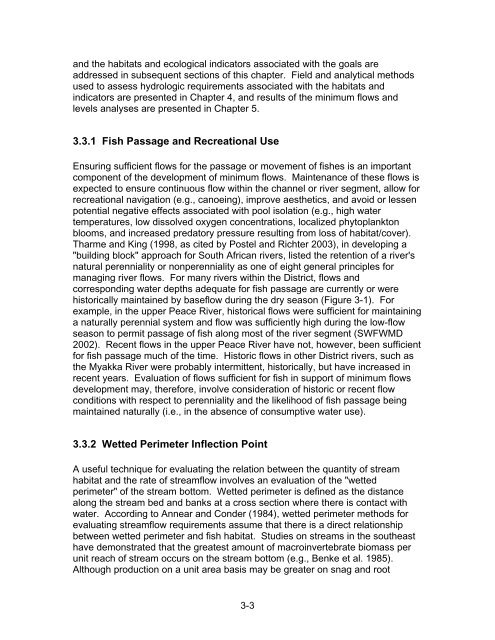Chapter 1 Minimum Flows and Levels - Southwest Florida Water ...
Chapter 1 Minimum Flows and Levels - Southwest Florida Water ...
Chapter 1 Minimum Flows and Levels - Southwest Florida Water ...
Create successful ePaper yourself
Turn your PDF publications into a flip-book with our unique Google optimized e-Paper software.
<strong>and</strong> the habitats <strong>and</strong> ecological indicators associated with the goals are<br />
addressed in subsequent sections of this chapter. Field <strong>and</strong> analytical methods<br />
used to assess hydrologic requirements associated with the habitats <strong>and</strong><br />
indicators are presented in <strong>Chapter</strong> 4, <strong>and</strong> results of the minimum flows <strong>and</strong><br />
levels analyses are presented in <strong>Chapter</strong> 5.<br />
3.3.1 Fish Passage <strong>and</strong> Recreational Use<br />
Ensuring sufficient flows for the passage or movement of fishes is an important<br />
component of the development of minimum flows. Maintenance of these flows is<br />
expected to ensure continuous flow within the channel or river segment, allow for<br />
recreational navigation (e.g., canoeing), improve aesthetics, <strong>and</strong> avoid or lessen<br />
potential negative effects associated with pool isolation (e.g., high water<br />
temperatures, low dissolved oxygen concentrations, localized phytoplankton<br />
blooms, <strong>and</strong> increased predatory pressure resulting from loss of habitat/cover).<br />
Tharme <strong>and</strong> King (1998, as cited by Postel <strong>and</strong> Richter 2003), in developing a<br />
"building block" approach for South African rivers, listed the retention of a river's<br />
natural perenniality or nonperenniality as one of eight general principles for<br />
managing river flows. For many rivers within the District, flows <strong>and</strong><br />
corresponding water depths adequate for fish passage are currently or were<br />
historically maintained by baseflow during the dry season (Figure 3-1). For<br />
example, in the upper Peace River, historical flows were sufficient for maintaining<br />
a naturally perennial system <strong>and</strong> flow was sufficiently high during the low-flow<br />
season to permit passage of fish along most of the river segment (SWFWMD<br />
2002). Recent flows in the upper Peace River have not, however, been sufficient<br />
for fish passage much of the time. Historic flows in other District rivers, such as<br />
the Myakka River were probably intermittent, historically, but have increased in<br />
recent years. Evaluation of flows sufficient for fish in support of minimum flows<br />
development may, therefore, involve consideration of historic or recent flow<br />
conditions with respect to perenniality <strong>and</strong> the likelihood of fish passage being<br />
maintained naturally (i.e., in the absence of consumptive water use).<br />
3.3.2 Wetted Perimeter Inflection Point<br />
A useful technique for evaluating the relation between the quantity of stream<br />
habitat <strong>and</strong> the rate of streamflow involves an evaluation of the "wetted<br />
perimeter" of the stream bottom. Wetted perimeter is defined as the distance<br />
along the stream bed <strong>and</strong> banks at a cross section where there is contact with<br />
water. According to Annear <strong>and</strong> Conder (1984), wetted perimeter methods for<br />
evaluating streamflow requirements assume that there is a direct relationship<br />
between wetted perimeter <strong>and</strong> fish habitat. Studies on streams in the southeast<br />
have demonstrated that the greatest amount of macroinvertebrate biomass per<br />
unit reach of stream occurs on the stream bottom (e.g., Benke et al. 1985).<br />
Although production on a unit area basis may be greater on snag <strong>and</strong> root<br />
3-3
















